
The Ampersand Painter was an ancient Greek artist known for creating vases and painted works.

The Ampersand Painter was an ancient Greek artist known for creating vases and painted works.
Like many ancient Greek artists, the real identity of the Ampersand Painter is not known. His modern name comes from the style of how he depicts the tail of a sphinx (a composite figure that combines a winged feline with a human head). In his vases, he paints the tail of the sphinx in a shape resembling an ampersand, which is shorthand for the word “and” (using the symbol &).
The “name vase” for this artist entered the collection of the Art Institute of Chicago in 1905. The object is a pyxis (small container for personal objects) and dates to about 580–570 BCE and is one of the artist’s earliest works. Only about 15 vases have been attributed to the Ampersand Painter. [1] The scenes created by this painter demonstrate near eastern influences in style and design. The preeminent scholar of Greek vase painters, John Beazley, attributed a number of vases to the Ampersand Painter; the scenes never depicts human figures, only animals, both imaginary and real.
The Ampersand Painter was active during the Archaic period (700–480 BCE) of ancient Greece, a time when influences from Eastern and Egyptian objects were making their way into the Mediterranean region. The city of Corinth, Greece, was a major trading post for much of this period and lead the way in adopting these new motifs onto vases. The Ampersand Painter was a Corinthian painter who decorated terracotta vases using the black-figure technique, which involved figures being painted in black with details created through incised lines. There is also a movement at this time to decorate every surface of the vase, leaving few empty spaces. [2]

Pottery, due to its relative durability, comprises a large part of the archaeological record of ancient Greece, and since there is so much of it, it has exerted a disproportionately large influence on our understanding of Greek society. The shards of pots discarded or buried in the 1st millennium BC are still the best guide available to understand the customary life and mind of the ancient Greeks. There were several vessels produced locally for everyday and kitchen use, yet finer pottery from regions such as Attica was imported by other civilizations throughout the Mediterranean, such as the Etruscans in Italy. There were a multitude of specific regional varieties, such as the South Italian ancient Greek pottery.

Black-figure pottery painting, also known as the black-figure style or black-figure ceramic, is one of the styles of painting on antique Greek vases. It was especially common between the 7th and 5th centuries BCE, although there are specimens dating as late as the 2nd century BCE. Stylistically it can be distinguished from the preceding orientalizing period and the subsequent red-figure pottery style.

Exekias was an ancient Greek vase painter and potter who was active in Athens between roughly 545 BC and 530 BC. Exekias worked mainly in the black-figure technique, which involved the painting of scenes using a clay slip that fired to black, with details created through incision. Exekias is regarded by art historians as an artistic visionary whose masterful use of incision and psychologically sensitive compositions mark him as one of the greatest of all Attic vase painters. The Andokides painter and the Lysippides Painter are thought to have been students of Exekias.

Red-figure vase painting is one of the most important styles of figural Greek vase painting.
Kleitias was an ancient Athenian vase painter of the black-figure style who flourished c. 570–560 BCE. Kleitias' most celebrated work today is the François Vase, which bears over two hundred figures in its six friezes. Painted inscriptions on four pots and one ceramic stand name Kleitias as their painter and Ergotimos as their potter, showing the craftsmen's close collaboration. A variety of other fragments have been attributed to him on a stylistic basis.

The Kleophrades Painter is the name given to the anonymous red-figure Athenian vase painter, who was active from approximately 510–470 BC and whose work, considered amongst the finest of the red-figure style, is identified by its stylistic traits.

The Berlin Painter is the conventional name given to an Attic Greek vase-painter who is widely regarded as a rival to the Kleophrades Painter, among the most talented vase painters of the early 5th century BCE.
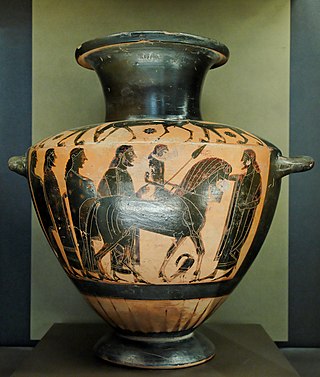
Lydos was an Attic vase painter in the black-figure style. Active between about 560 and 540 BC, he was the main representative of the '’’Lydos Group’’’. His signature, ό Λυδός, ho Lydos ", inscribed on two vases, is informative regarding the cultural background of the artist. Either he immigrated to Athens from the Lydian empire of King Kroisos, or he was born in Athens as the son of Lydian parents. In any case, he learned his trade in Athens.
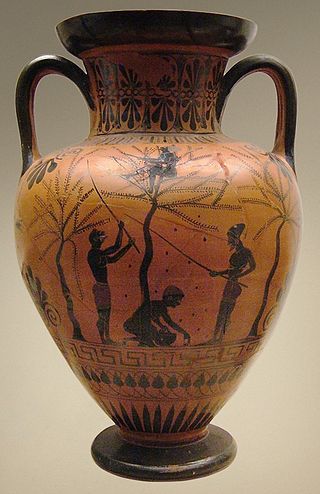
The Antimenes Painter was an Attic vase painter of the black-figure style, active between circa 530 and 510 BC.
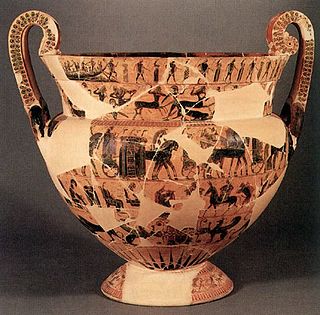
The François Vase is a large Attic volute krater decorated in the black-figure style. It stands at 66 cm in height and was inspired by earlier bronze vases. It was used for wine. A milestone in the development of ancient Greek pottery due to the drawing style used as well as the combination of related stories depicted in the numerous friezes, it is dated to circa 570/560 BCE. The François Vase was discovered in 1844 in Chiusi where an Etruscan tomb in the necropolis of Fonte Rotella was found located in central Italy. It was named after its discoverer Alessandro François, and is now in the Museo Archeologico in Florence. It remains uncertain whether the krater was used in Greece or in Etruria, and whether the handles were broken and repaired in Greece or in Etruria. The François Vase may have been made for a symposium given by a member of an aristocratic family in Solonian Athens, then broken and, after being carefully repaired, sent to Etruria, perhaps as an instance of elite-gift exchange. It bears the inscriptions Ergotimos mepoiesen and Kleitias megraphsen, meaning 'Ergotimos made me' and 'Kleitias painted me'. It depicts 270 figures, 121 of which have accompanying inscriptions. It is highly unusual for so many to be identifiable: the scenes depicted represent a number of mythological themes. In 1900 the vase was smashed into 638 pieces by a museum guard by hurling a wooden stool against the protective glass. It was later restored by Pietro Zei in 1902, followed by a second reconstruction in 1973 incorporating previously missing pieces.

The Brygos Painter was an ancient Greek Attic red-figure vase painter of the Late Archaic period. Together with Onesimos, Douris and Makron, he is among the most important cup painters of his time. He was active in the first third of the 5th century BCE, especially in the 480s and 470s BCE. He was a prolific artist to whom over two hundred vases have been attributed, but he is perhaps best known for the Brygos Cup, a red-figure kylix in the Louvre which depicts the "iliupersis" or sack of Troy.

The Nessos Painter, also known as Netos or Nettos Painter, was a pioneer of Attic black-figure vase painting. He is considered to be the first Athenian to adopt the Corinthian style who went on to develop his own style and introduced innovations. The Nessos Painter is often known to be one of the original painters of black-figure. He only worked in this style, which is shown on his name vase in the National Archaeological Museum in Athens. Most of the known Nessos Painter ceramics were found in funerary settings such as cemeteries and mortuaries.

The Amasis Painter was an ancient Greek vase painter who worked in the black-figure technique. He owes his name to the signature of the potter Amasis, who signed twelve works painted by the same hand. At the time of the exhibition, "The Amasis Painter and His World" (1985), 132 vases had been attributed to this artist.

The Pan Painter was an ancient Greek vase-painter of the Attic red-figure style, probably active c. 480 to 450 BC. John Beazley attributed over 150 vases to his hand in 1912:
Cunning composition; rapid motion; quick deft draughtsmanship; strong and peculiar stylisation; a deliberate archaism, retaining old forms, but refining, refreshing, and galvanizing them; nothing noble or majestic, but grace, humour, vivacity, originality, and dramatic force: these are the qualities which mark the Boston krater, and which characterize the anonymous artist who, for the sake of convenience, may be called the 'master of the Boston Pan-vase', or, more briefly, 'the Pan-master'.
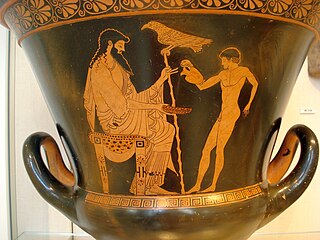
Eucharides Painter is the common nickname of an ancient Greek artist who decorated but did not sign Attic vases. Neither his real name, nor the dates of his birth and death are known. Presumably this artist was a pupil of the Nikoxenos Painter.

The Oreithyia Painter was an ancient Greek red-figure vase painter who flourished from 470–460 BCE. He is one of the many painters of the red-figure Classical Period, but his work is not considered the finest or well-known. This is partly because he began painting during the transition from red-figure to black-figure pottery.

The Gorgon Painter was one of the early Attic black-figure vase painters. He was active between 600 and 580 BC. His name vase, Dinos of the Gorgon Painter, is currently on display in the Louvre and depicts Perseus fleeing the Gorgons.
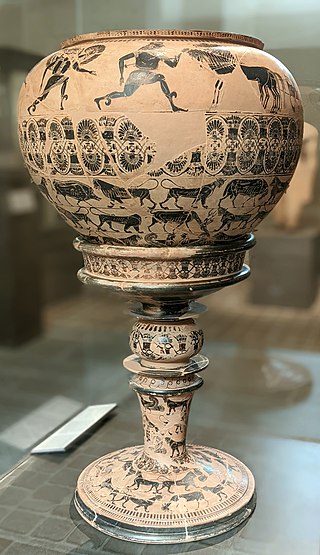
The Dinos of the Gorgon Painter is an important example of ancient Greek pottery, produced at Athens around 580 BC. It entered the Louvre's collection in 1861, with the purchase of Giampietro Campana's collection.

The calyx-krater by the artist called the "Painter of the Berlin Hydria" depicting an Amazonomachy is an ancient Greek painted vase in the red figure style, now in the Metropolitan Museum of Art, New York. It is a krater, a bowl made for mixing wine and water, and specifically a calyx-krater, where the bowl resembles the calyx of a flower. Vessels such as these were often used at a symposion, which was an elite party for drinking.

The Chicago Painter was an ancient Greek vase painter, active in Athens, Greece, in the middle of the 5th century BCE. His real name is unknown, but like many other ancient Greek vase painters, his style was recognized in several works by the British classical archaeologist and international authority of Attic Greek vases, Sir John Beazley (1885–1970). Beazley was exceptionally talented at identifying the individual signature styles of different Greek painters, which could be recognized in something as subtle as the composition of eyes, noses, or hands.
{{cite book}}: CS1 maint: multiple names: authors list (link)